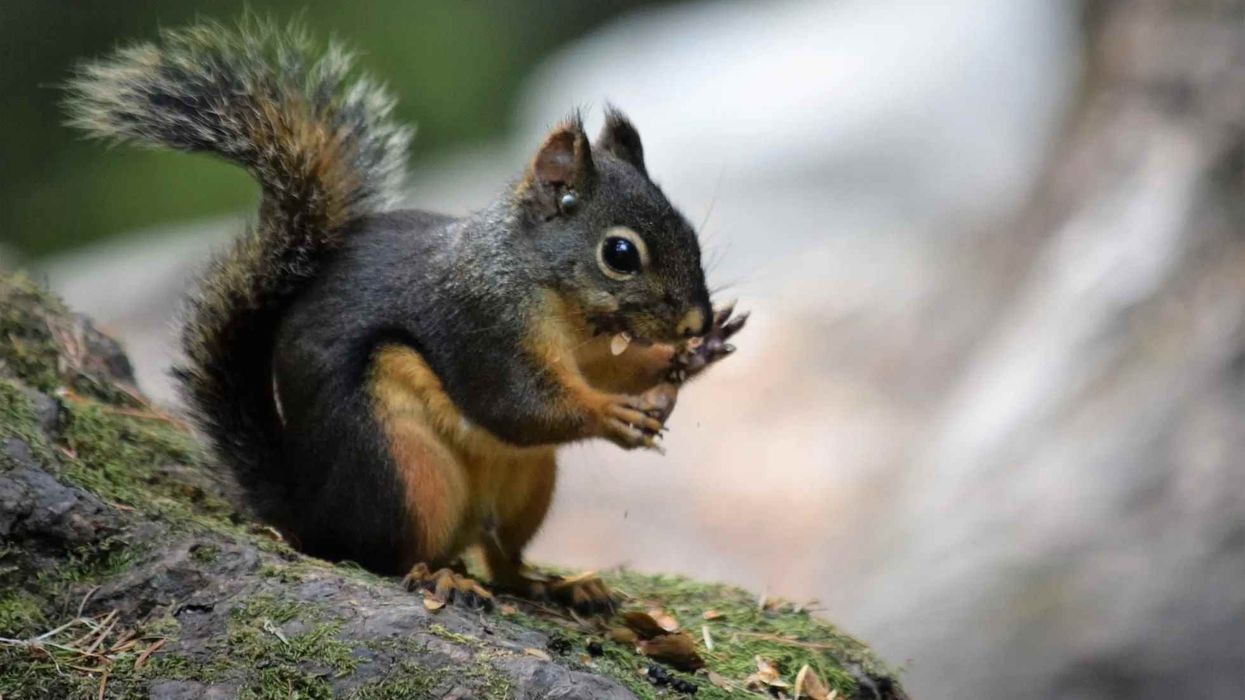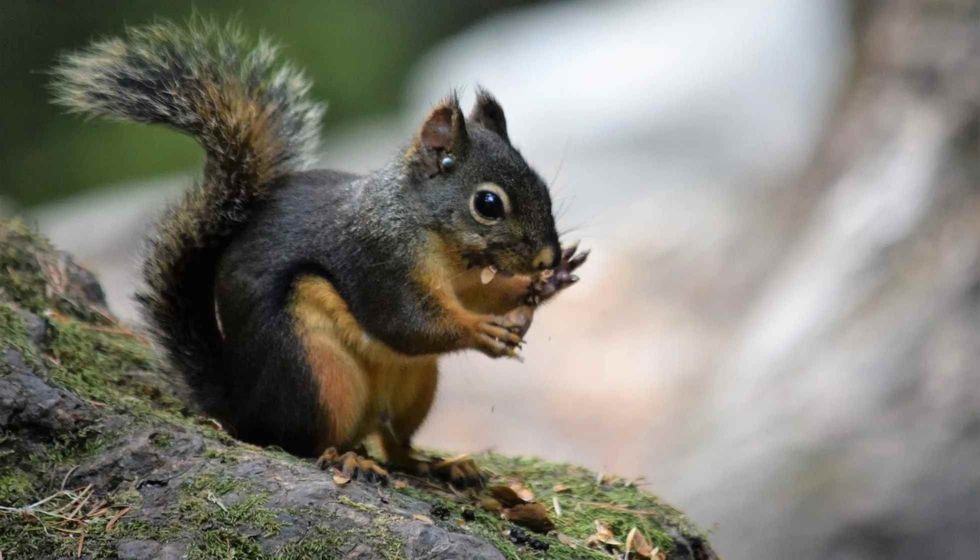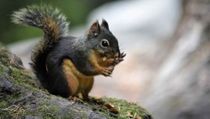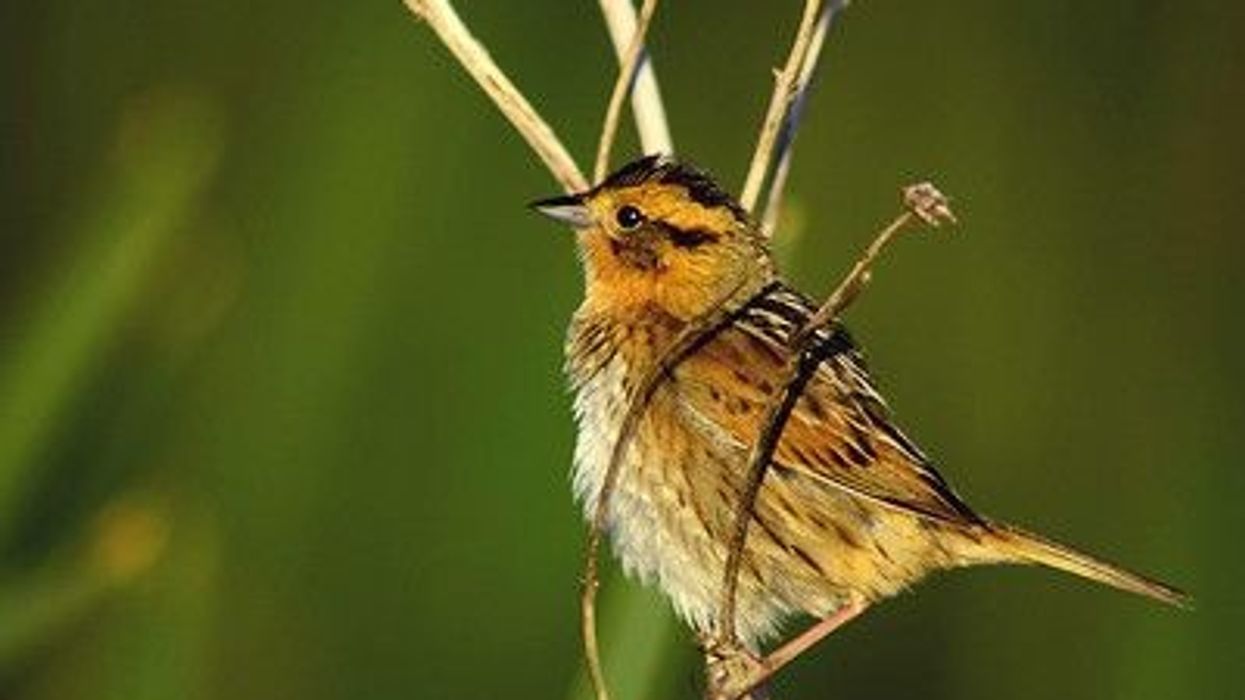Fun Douglas Squirrel Facts For Kids
The Douglas’s squirrel, or Douglas squirrel (Tamiasciurus douglasii), is a small tree squirrel. They are also known as Chikarees.
Their habitat stretches across the Pacific Coast in North America (Washington, Oregon, Sierra Nevada) and Canada (British Columbia). They live in coniferous forests that are filled with their favorite food, conifer seeds. Apart from the seeds of conifers (found in cones) like Shore Pine and Douglas Fir, the Douglas squirrel’s diet also includes nuts, fruits, and berries.
They are fond of fungi such as mushrooms and will eat birds’ eggs and baby birds if they get a chance. For the winter, they gather green cones and nuts like acorns and hazelnuts and hide them in the forest.
Douglas’s squirrels are gray with red or brown tones, and a reddish-brown tail. They have a dark stripe along their sides during the summer, which disappears in winter, as their fur becomes grayer.
They also have ear tufts that become thicker and more visible during the winter. The Douglas’s squirrels are very active during the day in summer and winter and prefer staying close to the ground and stay alert for danger from predators. They are also the chattiest type of pine squirrel with a wide range of calls.
If you like this article, check out pika facts and squirrel monkey facts.
Douglas Squirrel Interesting Facts
What type of animal is a Douglas squirrel?
The Douglas squirrel is a type of tree squirrel. They are a type of pine squirrel and are called that because they live in coniferous forests.
What class of animal does a Douglas squirrel belong to?
The Douglas squirrel, Tamiasciurus douglasii, belongs to the class Mammalia, order Rodentia, and the family Sciuridae.
How many Douglas squirrels are there in the world?
The population of the Douglas squirrel, Tamiasciurus douglasii, is stable, and conservationists have classified the species as of Least Concern. Their numbers may fluctuate depending on the availability of food, and these squirrels breed either once or twice a year, but their population remains stable.
Where does a Douglas squirrel live?
Douglas squirrels live in nests called dreys in the summer, and in cavities in trees in the winter. They might also live in abandoned bird nests, like woodpecker nests. These pine squirrels tend to be found in forests with much older trees.
What is a Douglas squirrel's habitat?
The habitat of the Douglas squirrel, Tamiasciurus douglasii, is spread across the coniferous forests, or other forests with conifer trees along the Pacific Coast. This includes the southernmost regions of British Columbia in Canada. In North America, populations of Douglas’s squirrels are found in western Washington, west and central Oregon, and the mountains of Sierra Nevada in northern California.
Who do Douglas squirrels live with?
Typically, Douglas squirrels prefer to live alone, except during the breeding season, when pairs of mated males and females will defend a single territory together. Young Douglas squirrels stay with their families for about a year till they are ready to have their own families. These squirrels breed from when they reach maturity, at around nine months.
How long does a Douglas squirrel live?
Douglas squirrel life expectancy is around five to six years in the wild.
How do they reproduce?
The breeding season of the species Douglas squirrels Tamiasciurus douglasii begins early in the year in February and lasts till April. If food is easily available, there is usually a second breeding season between August to September.
The Douglas Squirrel call out to each other during this time. The males and females will chatter at and chase each other before pairing off for the mating season.
Their reproduction involves monogamous pairs that produce one litter per season which comprises about four to six kits.
So there will be around 30 kits birthed in a Douglas squirrel's lifespan. These kits are born within a month and a half of mating season and stay with their families for up to a year till they leave to find their own territories.
What is their conservation status?
Currently, the population of the Douglas squirrel species is stable. According to the IUCN (International Union for Conservation of Nature), this squirrel species is classified as Least Concern, which means that there is no threat to their numbers. Sadly, the area and quality of their habitat is on a decline.
Douglas Squirrel Fun Facts
What do Douglas squirrels look like?
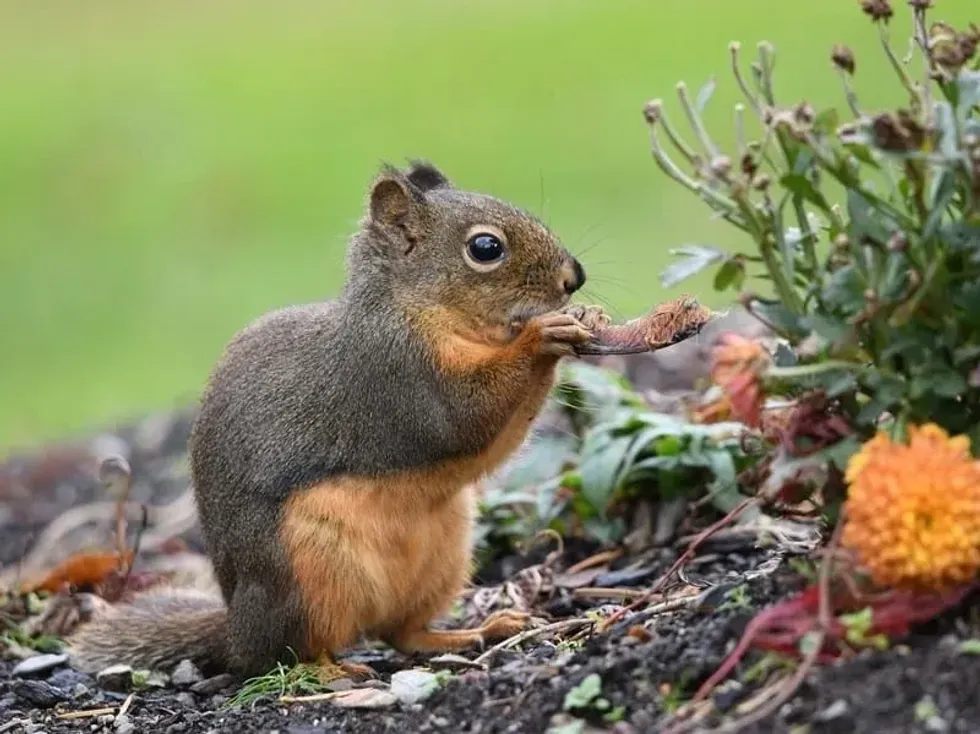
Douglas’s squirrels are fairly small for tree squirrels, reaching a maximum of 13.7 in (34.8 cm) including their bushy tails which are black at the tips. They also have white rings around their eyes. The Douglas squirrel will look different depending on the season.
In the summer, their fur is reddish-brown on the outside. The fur may be orange or fully black at the tips. On the inside, at their bellies, the Douglas squirrel has orange fur.
The underside of their tails is reddish-brown, as well as their summer coats. They have a dark line on their sides.
This line disappears in the winter, as their outer fur becomes grayer, and their bellies fade to yellow. This color change lets them blend into the cold forest better, keeping them safe from hungry predators. They have ear tufts through the year that also become more distinct in winter, to better protect them from the cold.
How cute are they?
Douglas squirrels are cute, especially since they are smaller than regular squirrels. Their big eyes, soft-looking ear tufts, and bushy tails make them some of the most adorable creatures in the rodent order.
They chatter constantly and run around looking terribly busy, which makes them seem that much cuter. The babies look very strange when they are newborns because they are furless and blind. Once the fur starts coming in, they look like adorable mini versions of their parents.
How do they communicate?
Douglas’ squirrels are one of the most vocal squirrels, which a wide range of calls that they use to communicate with each other. Douglas squirrel sounds include bark, scream, and chirp when they talk to each other and to other animals in the forest.
Their chatter is an important part of their mating rituals. Douglas squirrels yelling on the other hand is how they warn for danger from predators.
They also use their long bushy tails to communicate with each other, using the tail like a flag to tell other squirrels to stay out of their territory. Like other squirrels, the Douglas squirrel also uses scent marks to communicate.
How big is a Douglas squirrel?
Douglas squirrels range between 10.5-13.5 in long (27-34.8cm), and about 4-6 in (10-15 cm) of that is usually their tail. This makes them 1.3 times smaller than the average red squirrel, which can grow as long as 18 in (46 cm)! In fact, the Douglas squirrel is smaller than most rabbits!
How fast can a Douglas squirrel move?
On average, most kinds of squirrels can run at speeds that range between 8-10 mph (13-16 kph). Douglas squirrels tend to move very quickly and lightly, allowing them to run up and down trees and on the ground.
This is important because they need to be quick if they want to run away from animals like bobcats that try to eat them!
How much does a Douglas squirrel weigh?
A Douglas squirrel's weight range is between 4.9-11 oz (141-312 g). They are smaller than most red squirrels, which can weigh anything between 198-510 oz (7-18 g)!
Being so light lets the Douglas squirrels run around up and down trees as they go about their business of gathering conifer seeds and other food. Their weight also depends on the availability of food around them. In places where there is a lot of squirrel food available, the Douglas squirrel may grow a bit bigger!
What are the male and female names of the species?
Among all squirrels species, the male squirrels are called boars, and the female squirrels are called sows.
What would you call a baby Douglas squirrel?
Baby squirrels are called kits.
What do they eat?
The Douglas squirrel’s diet includes a wide variety of food like their other squirrel cousins. This includes pine seeds found in pine cones, fungi such as mushrooms, acorns, and other nuts, berries, and fruits.
They also eat other vegetation like twigs sap leaves buds, the cambium of conifers, and even pollen cones. Occasionally, the Douglas squirrel will eat arthropods, birds’ eggs, and even baby birds!
These squirrels store caches of food for the winter, enough to last about six to nine months of the cold. These animals tuck away acorns, hazelnuts, green pines, seeds, and even some fungi that thrive in the Douglas squirrel habitat.
These stores of food are spread throughout the forest in cavities in trees, in the moist ground near water sources, and underneath fallen logs. These food stores keep the squirrels fed through the cold winter when they prefer to stay warm and cozy in their nests.
Are they considered pests?
The Douglas squirrel prefers to live in forests full of coniferous trees, so they can eat their favorite food of pine seeds. However, there are times that it gets into homes and gardens in the more rural areas along the Pacific Coast where the distribution of their populations overlaps with human populations.
In these areas of Washington, Oregon, and California, the squirrels can enter homes through branches that reach into windows, and cause damage. They are very aggressive when they feel threatened.
Douglas squirrel yelling can be annoying. Douglas squirrels also cause damage to orchards when they gather nuts before they are ready.
Would they make a good pet?
With their small sizes and cute eyes, Douglas squirrels are very cute, and it can be tempting to keep them as pets! Squirrels are wild animals, so keeping them as pets would be very cruel, and make the animal unhappy. More importantly, keeping wild animals are pests is illegal in many states.
Douglas squirrels have not been domesticated. They are happiest when they are free to live close to their favorite foods, make their nests, and raise their families in coniferous forests. They need a lot of space and cannot be trained.
It is also difficult for people to arrange the diet that Douglas squirrels need to eat to be healthy. Squirrels are also aggressive. They have sharp nails and teeth that they use when they are scared, and squirrels get scared very easily!
Did you know...
When the weather is bad, Douglas squirrels will use their tails as a blanket, or even an umbrella! Their front teeth never stop growing, and they chew on shredded bark, twigs, sticks, and other solid objects they can find to keep them under control.
Douglas squirrels also have very flexible hind legs that can even bend backward! This helps them jump from branch to branch and up and down the trees in their habitat.
These squirrels also have an excellent range of eyesight and hearing. This, along with their whiskers which let them sense changes in their environment helps the squirrel be alert and aware of any possible danger, like from predators.
These squirrels do not hibernate like other squirrels but instead, spend the fall preparing for winter. They are larder hoarders.
Who is named after the Douglas squirrel and why?
Gymnast, Gabby Douglas, because of her impressive aerial performance on bars.
How big an area does a Douglas squirrel occupy?
Douglas squirrels are very territorial, and a single squirrel or a mated pair may defend an area! This means that the distribution of the population across their habitat is very wide.
During their mating season, they become slightly less territorial because there is more than enough food. On the other end, when their food supply is affected, they might abandon their territories altogether.
Here at Kidadl, we have carefully created lots of interesting family-friendly animal facts for everyone to discover! Learn more about some other mammals from our flying squirrel facts and xerus facts pages.
You can even occupy yourself at home by coloring in one of our free printable Douglas Squirrel coloring pages.
We Want Your Photos!
More for You
See All
Doctorate specializing in Veterinary Medicine

Oluniyi AkandeDoctorate specializing in Veterinary Medicine
With an accomplished background as a Veterinarian, SEO content writer, and public speaker, Oluniyi brings a wealth of skills and experience to his work. Holding a Doctor of Veterinary Medicine degree from the University of Ibadan, he provides exceptional consulting services to pet owners, animal farms, and agricultural establishments. Oluniyi's impressive writing career spans over five years, during which he has produced over 5000 high-quality short- and long-form pieces of content. His versatility shines through as he tackles a diverse array of topics, including pets, real estate, sports, games, technology, landscaping, healthcare, cosmetics, personal loans, debt management, construction, and agriculture.
Disclaimer
1) Kidadl is independent and to make our service free to you the reader we are supported by advertising. We hope you love our recommendations for products and services! What we suggest is selected independently by the Kidadl team. If you purchase using the Buy Now button we may earn a small commission. This does not influence our choices. Prices are correct and items are available at the time the article was published but we cannot guarantee that on the time of reading. Please note that Kidadl is a participant in the Amazon Services LLC Associates Program, an affiliate advertising program designed to provide a means for sites to earn advertising fees by advertising and linking to Amazon. We also link to other websites, but are not responsible for their content.
2) At Kidadl, we strive to recommend the very best activities and events. We will always aim to give you accurate information at the date of publication - however, information does change, so it’s important you do your own research, double-check and make the decision that is right for your family. We recognise that not all activities and ideas are appropriate for all children and families or in all circumstances. Our recommended activities are based on age but these are a guide. We recommend that these ideas are used as inspiration, that ideas are undertaken with appropriate adult supervision, and that each adult uses their own discretion and knowledge of their children to consider the safety and suitability. Kidadl cannot accept liability for the execution of these ideas, and parental supervision is advised at all times, as safety is paramount. Anyone using the information provided by Kidadl does so at their own risk and we can not accept liability if things go wrong.
3) Because we are an educational resource, we have quotes and facts about a range of historical and modern figures. We do not endorse the actions of or rhetoric of all the people included in these collections, but we think they are important for growing minds to learn about under the guidance of parents or guardians.
